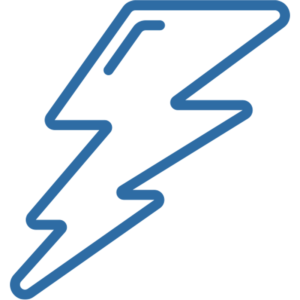 QUICK SUMMARY
QUICK SUMMARY
A logic model is a visual representation of an organization or program that shows what its inputs, activities, outputs and intended outcomes are. By putting those details down on paper, logic models are useful for helping leadership and staff clarify what the organization does, what its theory of change is, and how successful it is at achieving its mission.
 VIDEO OVERVIEW
VIDEO OVERVIEW
Coming soon
 STRATEGY DETAILS
STRATEGY DETAILS
Q1. What is a logic model?
A logic model is a detailed visual representation of an organization or office or program or initiative (we'll just say organization) that conveys its theory of change. It communicates how an organization works by depicting the intended relationships among its components:
- Inputs: The resources that the organization uses, whether people, materials, funding, and so on.
- Activities: What the organization does in its day to day work.
- Outputs: What the organization produces because of its activities.
- Outcomes: What the organization aims to achieve.
Figure 1 shows how these categories relate to each other in a logic model. In this case, we've chosen to divide outcomes into three categories, for a more detailed view of what the organization is aiming to achieve.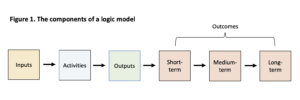 Notice how the first three boxes (inputs, activities and outputs) represent the planned work of the organization and represent "how we do our work." The second set of boxes, related to outcomes, represent the intend results of the organization's work and "why we do our work." Figure 2 shows these relationships.
Notice how the first three boxes (inputs, activities and outputs) represent the planned work of the organization and represent "how we do our work." The second set of boxes, related to outcomes, represent the intend results of the organization's work and "why we do our work." Figure 2 shows these relationships.
 Q2. Why are logic models important for results-focused leaders and their organizations?
Q2. Why are logic models important for results-focused leaders and their organizations?
Logic models are important and useful for several reasons, including:
- Generating a clear and shared understanding of how a program works. In other words, if program staff work together to create a detailed logic model, it helps to clarify what the program does and why.
- Improvement work. Once a program has created a logic model -- say during a leadership offsite -- it's a useful entrée into a discussion of where bottlenecks or other problems are occurring are how those could be addressed.
- Strategic planning work. Logic models help clarify what the program is trying to achieve which can be valuable for strategic planning work such as goal setting.
- Serving as foundation for program evaluation. Logic models are also a useful basis for a discussion around the question, "Is what we're doing as a program (our activities and outputs) actually producing the results (outcomes) we were hoping and expecting?" Answering that question is, in fact, a basic form of program evaluation.
Q3. What's an example logic model?
Figure 3 shows an example from a report published by the U.S. Department of Education of a logic model of a hypothetical computer-assisted math program within a school called Summing Up, designed to help students practice their math skills. The inputs include the software, teachers' time, associated fees, classroom space and other factors. Activities, meanwhile, focuses on what goes on within the program, including software use by students and teacher's related work. Next, outputs are what the program produces and includes students achieving the target level (90 hours per year) of engagement with the program. Lastly, outcomes are divided in this case into two categories -- short term and long term -- and related to the intended improvements in students' math abilities.
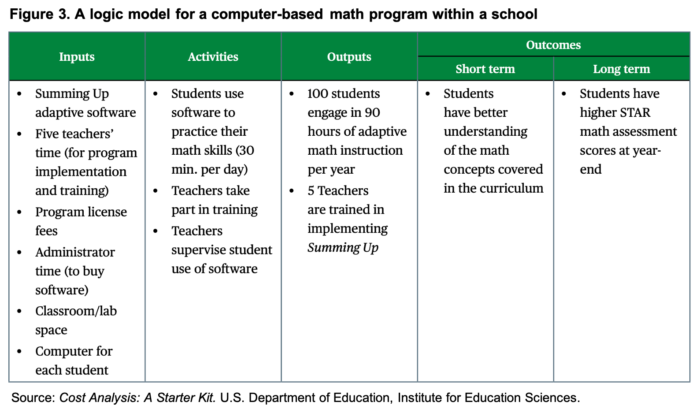
Q4. In which direction do you read or create a logic model?
You generally read a logic model from left to right, starting with inputs and reading how they translate into activities, outputs and outcomes.
When you develop a logic model, however, you can choose the direction that makes the most sense for your situation (see Figure 4):
- Left to right logic model development works best for programs that are up and running. It focuses on the "value chain" (how value is created by the organization) by putting on paper the inputs, then the activities created by those inputs, then the outcomes produced, and finally the desired outcomes.
- Right to left logic model development uses what might be called reverse logic and is especially useful if a program is being designed. The idea here is to write down the desired long-term outcomes to be achieved by the program and then work backwards: What nearer-term outcomes would be needed? What outputs would we need to produce to achieve those outcomes? And so on all, the way back to inputs.

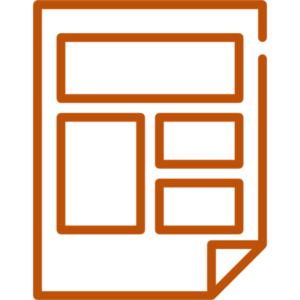 HANDOUTS / TEMPLATES
HANDOUTS / TEMPLATES
- Warm-up exercise: [Template here] For a team that is developing a logic model for their organization, it can be useful to start with a light-hearted practice version: creating a logic model for a summer vacation. This roughly 20-minute exercise can be done in breakout groups of three to five people, followed by presentations of their chosen destinations and logic models. Facilitators can provide quick feedback on the logic models. Note that some groups may define activities as preparation for a vacation (e.g., buy a guidebook or book tickets) while others may define them as vacation activities (e.g., go snorkeling or relax on the beach), providing an opportunity for the facilitator to underscore that logic model categories can be interpreted differently depending on the purpose.
- Organizational logic model development exercise: [Template here] This template can be used for a facilitated group exercise to enable staff to develop a logic model for their organization -- for example, a 60-minute exercise, whether in breakout groups or as a full group.
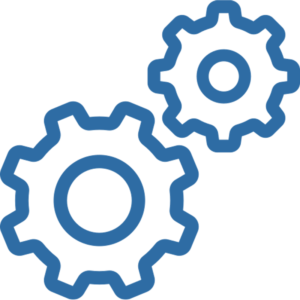 ADDITIONAL RESOURCES
ADDITIONAL RESOURCES
- Article: “One Key to Making a Leadership Offsite a Success: Logic Models,” by Andrew Feldman, Government Executive.
- Chapter: Chapter 1, "Introducing Logic Models," is available for free online of the book The Logic Model Guidebook by Lisa Wyatt Knowlton and Cynthia Phillips.
- Gov Innovator podcast interviews:
- Five questions public agencies should ask to put their logic models to work: Cynthia Phillips, formerly National Science Foundation
- Using logic models, a key building block of results-focused programs: Tom Chapel, Centers for Disease Control and Prevention
 CUSTOMIZED ASSISTANCE
CUSTOMIZED ASSISTANCE
Please contact us if your organization needs assistance in developing logic models or facilitating workshops to do so.
![]() PDF VERSION OF THIS PAGE (click here)
PDF VERSION OF THIS PAGE (click here)
